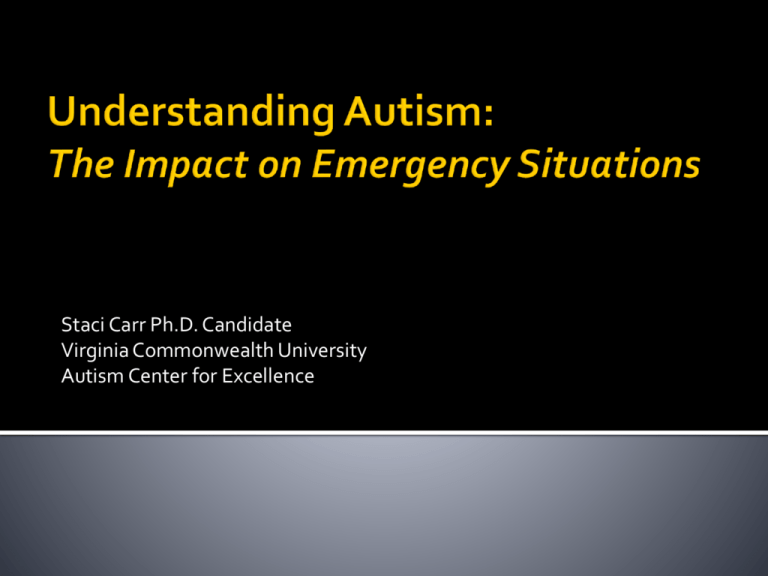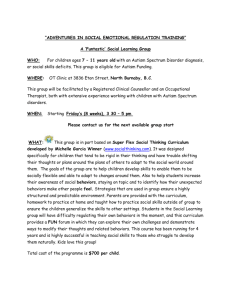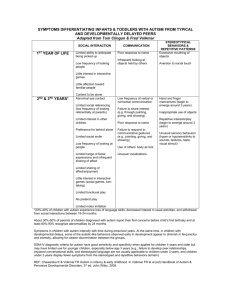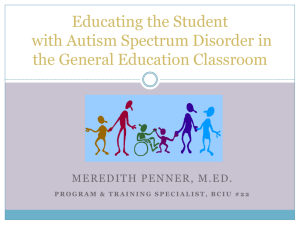Autism Spectrum Disorders: Understanding Behavior
advertisement

Staci Carr Ph.D. Candidate Virginia Commonwealth University Autism Center for Excellence Explore and learn common characteristics of individuals with ASD including: social, behavioral, and communication. Explore the “spectrum” of Autism with respect to functioning and age Learn practical applications of strategies to assist in creating positive and productive interactions with individuals with ASD. Primary and Secondary Characteristics Asperger’s Syndrome Autism Rett’s Syndrome PDD- NOS Childhood Disintegrative Disorder Toddlers Early Childhood Adolescence Young Adulthood Adulthood “If you’ve met one child with autism, you’ve met one child with autism.” -Stephen Shore 7 Deficits in Social Interaction Deficits in Communication Presence of Restricted, Repetitive, and Stereotyped Repertoire of Activities Social Communication Behavior Passive Active Non-verbal Highly Verbal Simple Complex What does it look like? Tendency: Respond to others Eye gaze or gestures Brief turn-taking Perseverative interactions Weakness: Initiate interactions Combine eye gaze and gesture Reciprocal interaction Share with others Flexible interactions Pragmatic language Understanding non-verbal cues, gestures, eye-contact Interpreting language literally Perspective taking What does it look like? Tendency: Weakness: Inappropriate Space, interactions, • Infer emotional aloof, withdrawn states • Sensory sensitivities • Anxiety • Sensory Processing Differences ASD Behavior Challenges Mental Health Diagnoses Behaviors can be positive or negative All Behaviors communicate 5 Functions of Behavior M- Medical E- Escape A- Attention T- Tangible S- Sensory Destructive Behaviors Aggressive, Self-Injurious, Property Destruction, Injury to others, Throw, Push, Harmful Behavior with Hands, Feet, etc. Disruptive Behaviors Tantrums, Loud Noise/Screaming/Crying, Running, Repetitive Noises, etc., Talking Out, Negative Comments Interfering and/or Irritating Behaviors Self-stimulation, Repetitive and Perseverative Speech—Questions, Argumentative, Poor Task Completion Difficulty conceiving that others have their own thoughts Difficulty understanding what others are thinking Always tries to follow own agenda—not others Upset by minor changes—not minor for the individual Know sequence of behaviors that results in increased anxiety, frustration, stress (behavior chain) and emotional episode, tantrums, out of control behavior Intervene before escalation reaches half-way point Allow to calm, then return to activity If loses control, allow ―melt down‖ to run its course Avoid excessive, talking, questioning, handling People with ASD typically have a varying pattern of hyper (over) and hypo (under)-sensitivity to sensory stimuli Strong sensory experiences trigger flight, fight, or fright The person may avoid such experiences Weak sensory experiences trigger a craving for sensory information The person may seek such experiences 21 Self Injurious Behavior Aggression Towards Others Darting/Wandering/ Escape Excessive Self Stimulatory Behavior 22 Higher rate of depression Higher rate of anxiety disorders Higher rate of other co-morbidities 23 Do's & Don'ts Meltdown of the Individual Restraining and Retaining At the Emergency Room Do: One of the most important skills a person can have is the ability to be calm and comforting in a crisis or “meltdown” situation. A comforting adult may: • talk softly and share encouraging words • repeat a calming phrase • or simply keep one’s own body relaxed (Kluth) “The more you try to control the situation, the less control you will have!” Social situations without guidelines Overestimating their control and understanding due to their intelligence Noise Getting upset when they get upset Getting offended with their social limitations Overestimating their receptive language skills Visual Supports – modify so they blend in (written format) Consistent routines Providing ways to modulate sensory needs Help them see others’ perspective Plan and warn about transitions Use special interests to motivate, but then move them on through those interests to other areas Visual Supports: anything we see that enhances our communication and understanding Can include: body language, natural environmental cues, traditional organizational tools, etc. Broad category: visual schedules, choice boards, task completion/skill development Used to increase structure and predictability Can be used to, remind about daily routines, help break tasks down into small units For younger children and those with limited language skills, use pictures or icons For individuals who can read, use written descriptions with or without pictures to regulate social behavior \ Reduce stress and/or redirect if student is escalating Personal Space: Be aware that your personal space may be invaded, or that the individual may NOT respond well to you invading theirs. Speak calmly and softly. Speak in direct, short phrases such as: “Stand up now.” or “Get in the car.” Avoid slang expressions, such as: “What’s up your sleeve?” or “Are you pulling my leg?” Allow for delayed responses (10-15 seconds) to your questions or commands. May even be as long as 30 seconds. Repeat or rephrase after a non response of 20-30 seconds. Consider use of pictures, written phrases/commands, computer images. Use minimal gestures for attention; avoid pointing or waving. Examine for presence of medical alert jewelry or tags, or an autism identification card to get name, address, etc. Model calming body language (such as slow breathing and keeping hands low) Demonstrate the behavior you want the person to display (how you want them to sit, stand, lay, etc.) A person with autism may not react well to changes in routine or the presence of strangers, even a uniformed responder. Be prepared to use short directions. Officers should not interpret the person’s failure to respond to orders or questions as a lack of cooperation or a reason for increased force. Ask parent or others at the scene about how to communicate with and deescalate the person’s behavior. Avoid stopping repetitive behaviors unless there is risk of injury to yourself or others. If person is holding and appears to be engaged with an inanimate object, consider allowing individual to hold the item for the calming effect. Evaluate for injury: person may not ask for help or show any indications of pain, even though injury seems apparent. Be aware that the person may be having a seizure (high incidence rate of seizure disorder) Be aware of person’s self-protective responses and sensitivities to even usual lights, sounds, touches, orders, and animals - canine or mounted patrol If possible, turn off sirens and flashing lights and remove other sensory stimulation from the scene (crowds, animals, etc.) If person’s behavior escalates, use “geographic containment” and maintain a safe distance until any inappropriate behaviors lessen (Debbaudt & Legacy, 2005) Stay alert to the possibility of outbursts or impulsive acts Use your discretion. If you have determined that the person is unarmed and have established geographic containment, use all available time to allow the person to deescalate themselves without your intervention. If in custody, alert jail authorities. Consider initial isolation facility. Person would be at risk in general prison population. Each individual with autism is unique and may act or react differently. While these are helpful hints for interacting with individuals with ASD, they may not always work. Search & Rescue: Effective Communication Searching Communication Restraining Entering & Exiting Rescue from Heights Where? Favorite spot? Interest? Park Neighbor’s house How to approach? Remember the 25 helpful hints Verbal or Non-verbal? Do you have visual supports handy? Tone of voice Length of sentence Body posture and personal space BE CAREFUL!!! Hands off is the best idea Do not try to STOP a “meltdown” Block and redirect Unless…. At risk of injuring self or others Remember that many individuals with ASD do not like to be touched… Entering: Calm, Slow, Low numbers (no need for show of force– may escalate the situation) Exiting: Appropriate escorting, Using visual supports for transitions, Transition item Many individuals lack a sense of danger REMAIN CALM Do not startle Short directions with visual supports Patience Consider luring with a preferred or high interest item High school student with Asperger’s syndrome Very bright and gifted in math and computers Really scared of weather although knowledgeable about it and can tell you all about fronts, storms, etc. Tornado hits the area while he is at Target and he becomes very upset and abusive to mom while in the store. Manager calls Police What do you do? 11 year old girl with autism Does not use words to communicate Teacher tells you that she does not handle transitions well Has a seizure at school and needs to be taken to the ER What do you do? Staci Carr Virginia Commonwealth University Autism Center for Excellence 1314 West Main Street Richmond, VA 23284 secarr@vcu.edu 804-828-1247 www.vcuautismcenter.org






